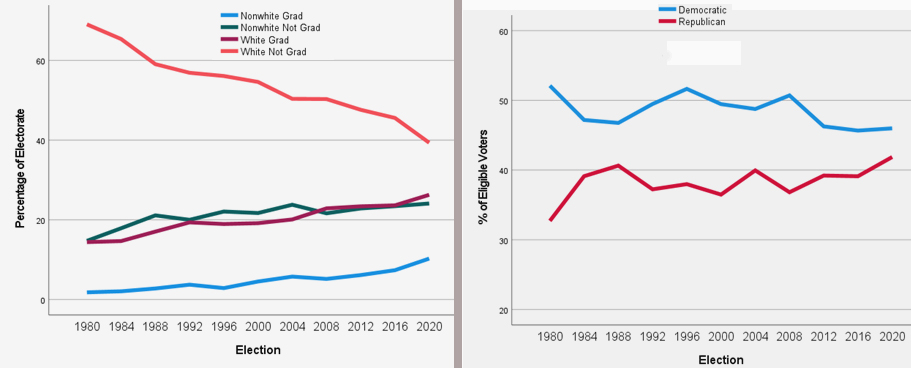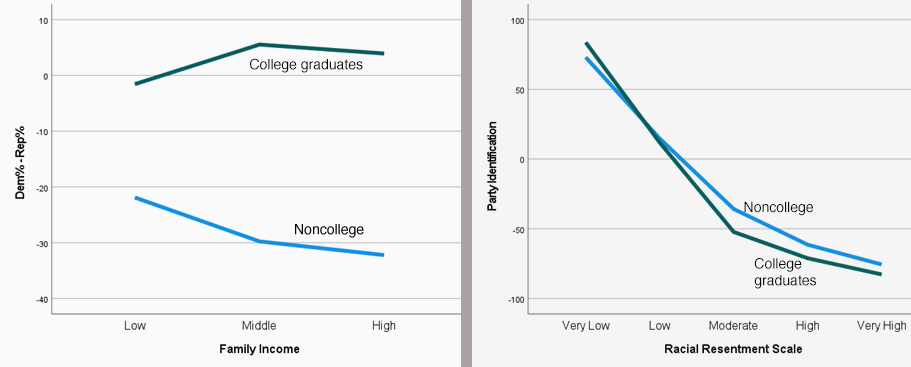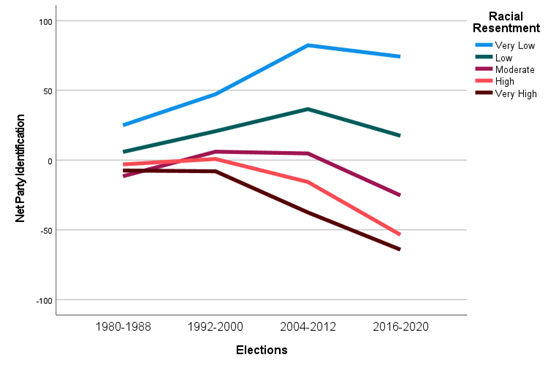

James Carville once famously said: "It's the economy, stupid." He was wrong. The driving force in American politics isn't the economy or even educational levels. It's racial resentment. A detailed analysis of the electorate by Alan Abramowitz, a professor of political science at Emory University, based on a large data set spanning 40 years, shows this quite clearly in multiple graphs and tables. It's quite wonky, but what did you expect from a statistical analysis of the voters going back four decades? Here are some of the key takeaways, starting with these two graphs:

On the left above, we see that in 1980, the electorate was about 70% white noncollege voters. Now they are just under 40%. In contrast, there have been increases in the number of white college graduates and nonwhites, both with and without college educations. That is a stupendous shift. It is not surprising that noncollege whites have noticed their loss of power. Archie Bunker would certainly have noticed.
On the right above, we see party identification over the years. In 1980, Democrats outnumbered Republicans by 19 points. Now it is 4 points. Given that Democratic demographics like nonwhites and college graduates have grown, why have the Democrats lost so much ground? It appears to make no sense. But it does.
What is happened is that white noncollege graduates used to be strongly Democratic. Now they are strongly Republican, so much so that even with their smaller numbers they are keeping the Republican Party afloat. The next question is: Why did former blue-collar Democrats become Republicans? There are two popular theories. First, it is economic stress. Second, it is racial resentment. Abramowitz looked at the data and came up with these two graphs:

The graph directly above on the left shows net Democratic identification (i.e., Democrats minus Republicans) by income for both college grads and noncollege voters. The green line shows that poor college grads (say, English majors), are roughly equally split between Democrats and Republicans. Among wealthier college grads (say, pre-med majors), there is a slight preference for Democrats, but the effect isn't very big. For noncollege voters, poor ones dislike the Democrats by about 22 points and rich ones dislike them even more, by about 32 points. So income does matter, but the effect is not gigantic. One would expect that if noncollege voters had moved to the Republicans due to economic stress, then as they got richer, the effect would be less. Actually, the reverse is true.
The graph of the right uses the standard four-item racial resentment scale. Subjects are asked if they agree or disagree with these four statements.
From the answers, a "racial resentment score" is compiled by appropriate weighting. It is the x-axis in the graph on the right. Here, the effect on party identification is dramatic. People who bear no resentment against Black people are very heavily Democratic. People who resent Black people heavily and think they are lazy and their condition is their own fault are very heavily Republican. This is true for both college graduates and noncollege people. And the effect is not due to income, as the graph on the left shows.
Finally, one more graph—we warned you the study was wonky. This shows the partisan identification (D-R) of noncollege whites over time:

Here we see that in 1980, racial resentment had a modest effect, but by 2020 it was gargantuan. Over time, noncollege whites with a low racial resentment score have become more Democratic but noncollege whites with a high racial resentment score have become very Republican.
This is the vein Donald Trump (and, to a lesser degree) Ron DeSantis have tapped into. They are appealing to racial resentment, pure and simple. Why is Trump still so popular with this base? Did he improve their economic situation during his time as president? Did he achieve a higher minimum wage, stronger unions, more social programs to help people undergoing economic stress? Not at all. Did he blame Black people (and, for that matter, Latinos and Arabs and other minority groups) for crime and what ails America? In the immortal words of Sarah Palin, "you betcha." That resonated. Carville was wrong. It is not the economy.
This puts the Democrats in a bind. They are certainly not going to try to out-racist the Republicans and raising the minimum wage may not matter much since these voters are not responsive to it. It is not clear what they should do. Maybe try to do better with Latinos and win over even more college graduates. It will call for a lot of creativity. (V)